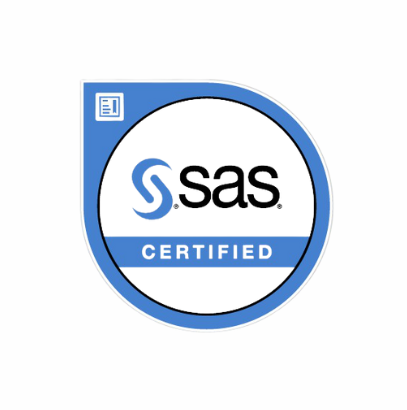
SAS training
(Duration: 18hrs.)
Download, Install and upgrade the SAS
01
Introduction to SAS Environment
An Overview of the SAS System | SAS Tasks | SAS & SQL A Comparison
SAS data types | Variable Naming Convections | SAS File extensions
Output produced by the SAS System | SAS Tools (SAS Program – Data step and Proc step)
A sample SAS program | SAS Library
02
Installation & setup
Creating SAS Account
Setting up VM-Ware for SAS
Installing SAS University Edition
03
Reading Raw Data from External File
Introduction to Raw Data
Factors considered to examine the raw data
Formats / Informats
Reading Unaligned Data (List Input)
Reading Data Aligned to Columns (Column Input)
Reading Data that requires Special Instructions (Formatted Input) | Controlling the position of the Pointer in Formatted Input
1. Absolute – Column pointer control (@)
2. Relative- Column pointer control (+)
Mixed Style Input (Mixing List, Input. Formatted Input styles in one INPUT Statement)
Using colon (:) modifier to specify an informat in the INPUT Statement )
Recognize delimiter in the raw data file (Using DLM= option in INFILE Statement
Missing data at the end of row (Using MISSOVER option in INFILE statement)
Missing values without placeholders (DSD option in INFILE statement)
04
How SAS works (Flow of Data Step Processing - Compilation & Execution phase)
Input Buffer
Program data vector (PDV)
Descriptor Information of a SAS Dataset
05
Data Transformations
Operators
Decision making in SAS
1. Conditional Processing using IF-THEN and ELSE statement
SAS Date Values
Managing Dates
Length Statement
Analyzing data using Loops
1. DO WHILE Statement
2. DO UNTIL Statement
3. Iterative DO loop Processing
4. Where Statement OR Where Condition (dataset)
5. Deciding whether to use a Where statement or Subsetting IF statement
06
Reading Datasets
Selecting Variables and observations (DROP or KEEP statement and DROP= or KEEP = dataset options)
Controlling which Observations are read (OBS= FIRSTOBS = Options)
The _ERROR_ Automatic Variable
The_N_Automatic Variable
Creating Subset of observations
Accumulating Totals for a Group of Data (BY- Group Processing (First & Last)
Multiple BY variables
DATASETS Procedure ( To modify the Variable name/label/format/informat)
Reading SAS datasets and Creating Variables
Creating an Accumulating Variable (The RETAIN Statement)
The DELETE Statement
The SUM Statement
The RENAME = Data Set option
07
Combining SAS datasets
1. Concatenating SAS Data Sets Using SET statement in DATA Step
2. Inter Leaving SAS Data Sets
3. Match-Merging
4. Appending
5. Excluding Unmatched Observations.
08
Processing Variables with Arrays
Single Dimension Array
Multi Dimension Array
09
Reading Data from External Files (Part2)
Generating a Single observation from Multiple Records
Generating Multiple Observations from Single Records
Reading Hierarchical Files
Reading Excel Files
10
Producing Descriptive Statistics
Using PROC Means
Limiting Decimal Places
Using Proc Frequency
Using Proc Summary
11
ODS - Output Delivery System
Transforming data with SAS functions
Manipulating Character Values (SUBSTRING / RIGHT / LEFT / SCAN/ CONCATENATION
TRIM / FIND / INDEX / UPCASE / LOWCASE / LENGTH )
Converting data using functions ( PUT / INPUT )
12
Creating & Applying User Defined Formats
Proc Format
13
PROC SQL – Using SQL in SAS
PROC SQL – Using SQL in SAS
14
Graphics in SAS
PROC Charts
PROC Plots
PROC UNIVARIATE
PROC SGPLOT
15
Macros in SAS
MACRO VARIABLES
PARAMETERIZED MACROS
AUTOMATIC MACRO VARIABLES
MACRO CONDITIONS
DATA DRIVEN PROGRAMS